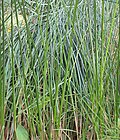Note: This is a project under development. The articles on this wiki are just being initiated and broadly incomplete. You can Help creating new pages.
Difference between revisions of "Cyperus articulatus"
| Line 1: | Line 1: | ||
[[File:Cyperus articulatus.jpg|thumb|right]] | [[File:Cyperus articulatus.jpg|thumb|right]] | ||
| + | |||
'''Cyperus articulatus''' is a perennial, grass-like plant. Piripiri is a valued plant throughout its wide range. The native peoples of the Amazon ascribe magical properties to this plant. It is used in the herbal systems of many countries where it is particularly valued for its beneficial effect upon the digestive system. It is sometimes cultivated for the many uses of its rhizome, and is often sold in local markets | '''Cyperus articulatus''' is a perennial, grass-like plant. Piripiri is a valued plant throughout its wide range. The native peoples of the Amazon ascribe magical properties to this plant. It is used in the herbal systems of many countries where it is particularly valued for its beneficial effect upon the digestive system. It is sometimes cultivated for the many uses of its rhizome, and is often sold in local markets | ||
==Uses== | ==Uses== | ||
Latest revision as of 15:41, 14 October 2020
Cyperus articulatus is a perennial, grass-like plant. Piripiri is a valued plant throughout its wide range. The native peoples of the Amazon ascribe magical properties to this plant. It is used in the herbal systems of many countries where it is particularly valued for its beneficial effect upon the digestive system. It is sometimes cultivated for the many uses of its rhizome, and is often sold in local markets
Contents
- 1 Uses
- 2 Parts Used
- 3 Chemical Composition
- 4 Common names
- 5 Properties
- 6 Habit
- 7 Identification
- 8 List of Ayurvedic medicine in which the herb is used
- 9 Where to get the saplings
- 10 Mode of Propagation
- 11 How to plant/cultivate
- 12 Commonly seen growing in areas
- 13 Photo Gallery
- 14 References
- 15 External Links
Uses
Fevers, Flu, Throat cancer, Snake bite, Baldness, Headaches, Colds, Mouth sores, Hypertension, Nausea, Vomiting.
Parts Used
Chemical Composition
Common names
| Language | Common name |
|---|---|
| Kannada | |
| Hindi | |
| Malayalam | |
| Tamil | |
| Telugu | |
| Marathi | |
| Gujarathi | |
| Punjabi | |
| Kashmiri | |
| Sanskrit | |
| English |
Properties
Reference: Dravya - Substance, Rasa - Taste, Guna - Qualities, Veerya - Potency, Vipaka - Post-digesion effect, Karma - Pharmacological activity, Prabhava - Therepeutics.
Dravya
Rasa
Guna
Veerya
Vipaka
Karma
Prabhava
Habit
Identification
Leaf
| Kind | Shape | Feature |
|---|---|---|
Flower
| Type | Size | Color and composition | Stamen | More information |
|---|---|---|---|---|
| {{{5}}} |
Fruit
| Type | Size | Mass | Appearance | Seeds | More information |
|---|---|---|---|---|---|
Other features
List of Ayurvedic medicine in which the herb is used
Where to get the saplings
Mode of Propagation
How to plant/cultivate
Grows naturally from the warm temperate zone through to the tropics. Probably requires a moist to wet soil.[3]
Commonly seen growing in areas
Damp areas along the rivers, Flooded areas, Marshy areas along the rivers.
Photo Gallery
References
- ↑ [Chemistry]
- ↑ [Morphology]
- ↑ Cultivation
External Links
- Ayurvedic Herbs known to be helpful to treat Fevers
- Ayurvedic Herbs known to be helpful to treat Flu
- Ayurvedic Herbs known to be helpful to treat Throat cancer
- Ayurvedic Herbs known to be helpful to treat Snake bite
- Ayurvedic Herbs known to be helpful to treat Baldness
- Ayurvedic Herbs known to be helpful to treat Headaches
- Ayurvedic Herbs known to be helpful to treat Colds
- Ayurvedic Herbs known to be helpful to treat Mouth sores
- Ayurvedic Herbs known to be helpful to treat Hypertension
- Ayurvedic Herbs known to be helpful to treat Nausea
- Ayurvedic Herbs known to be helpful to treat Vomiting
- Herbs with Rhizomes used in medicine
- Habit - Perennial
- Index of Plants which can be propagated by Seeds
- Index of Plants which can be propagated by Division
- Herbs that are commonly seen in the region of Damp areas along the rivers
- Herbs that are commonly seen in the region of Flooded areas
- Herbs that are commonly seen in the region of Marshy areas along the rivers
- Herbs
- Pages without herbs images


